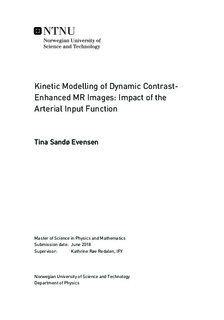Kinetic Modelling of Dynamic Contrast-Enhanced MR Images: Impact of the Arterial Input Function
Master thesis
Permanent lenke
http://hdl.handle.net/11250/2561839Utgivelsesdato
2018Metadata
Vis full innførselSamlinger
- Institutt for fysikk [2677]
Sammendrag
The standard treatment of rectal cancer is surgery, and in locally advanced cases, neoadjuvant chemoradiotherapy (CRT). By obtaining knowledge about the aggressiveness of tumours prior to treatment, the treatment can be adapted individually, which may contribute to an improved quality of life and survival for the patients. In this thesis, the potential of using parametric models in dynamic contrast enhanced (DCE) magnetic resonance imaging (MRI) for this purpose has been explored.
DCE-MRI data of 91 rectal cancer patients were analysed in Matlab using two parametric analysis models: the Tofts and Kermode (TK) model and the Brix model. In order to explore the potential of the models for assessing treatment response and aggressiveness, and determine the significance of the arterial input function (AIF), both a population-based AIF and individual AIFs were applied to the TK model, and compared to the (AIF-independent) Brix model. The TK model parameters Ktrans, ve, vp, and kep, and the Brix model parameters ABrix, kel and kep were estimated within the tumour volumes of the patients. Pretreatment and post-CRT parameter medians and median parameter changes were tested for associations with aggressiveness and treatment response using a Mann-Whitney U test. For the statistically significant pretreatment associations, statistical analysis was additionally performed on percentile parameter values and histogram quantities.
For the pretreatment medians, associations were found for ve in the individual AIF-based TK model, for ABrix and kep in the Brix model, and for the histogram analysis in the relative peak height of kep in the Brix model. For the post-CRT medians, associations were found for Ktrans and vp in both versions of the TK model, and for kep in the Brix model and individual AIF-based TK model. For median parameter changes, associations were found for Delta ve in both versions of the TK model, and for Delta kep in the Brix model.
This study showed that parametric modelling can be used to identify patients who require either no surgery or less advanced surgery, which may improve the expected quality of life, and patients in need of more advanced CRT regimes, which may improve the overall survival.
